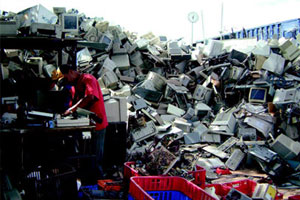
HYDERABAD: Wondering how to get rid of old phone chargers and computer keyboards or mouse are no longer working? Many residents of legs to withdraw carelessly, is not aware of the environmental consequences of this action. The sale to local kabadiwala also mean that these e-products eventually end up in incinerators, does more harm than good.
With the safe disposal of electronic waste is still at a nascent stage, people are exposed to hazardous chemicals, toxic gases and heavy metals, experts working with the management of electronic wastes say. About 95 percent recycling of electronic waste in the city is still carried out in the informal sector which employs an army of dismantlers in places like Old Town and Hyderguda Mallepally metals segregate waste or by incineration.
In an effort to raise awareness of the dangers of improper disposal of e-waste and recycle it safely, a project funded by the World Bank Clean E-initiative was launched in four cities like Hyderabad, Delhi, Mumbai and Ahmedabad last year. Guide Development Foundation, the implementing NGO in Hyderabad confident Clean E-initiative, in collaboration with Attero, an electronics company asset management, has begun the Herculean task of recycling electronic waste.
Under the project, the NGO has so far collected 30 tons of electronic waste through its five collection centers authorized Kukatpally, Khairatabad, Hafeezpet, Jubilee Hills and Secunderabad. After packaging the electronic waste is sent to Attero facilities in Roorkee for dismantling, segregation and recycling.
Thirty tons is a tiny amount, because even by a conservative estimate, if it is assumed that each of the 25 lakh households in Greater Hyderabad Municipal Corporation (GHMC) limits produces 5kg electronic waste per year, would add up to 10,000 metric tons (MT) of e-waste in a year.
This should not be surprising since between cities of India, Hyderabad has been ranked the fifth highest generator of e-waste in a study by the Institute of Environment Protection Training and Research based in Hyderabad (EPTRI) in 2009. based on a sample survey with 246 respondents, the report went on to predict that the annual turnover of e-waste in Hyderabad was 6743.87MT (in 2009) and clunky 1,07,886 MT in the next five years, ie 2013.
How shoddy treatment of electronic waste is a serious concern. Electronic and electrical waste and discarded televisions, monitors, printers, mobile phones, circuit boards and refrigerators contain chemicals and metals such as lead, cadmium, chromium, mercury, polyvinyl chloride (PVC), brominated flame retardants, beryllium, antimony, arsenic, mercury, leachate, dioxins and phthalates, which either produce toxic gases when burned or seeps into groundwater when buried in landfills.
The EPTRI report adds that long-term exposure to these harmful elements could cause cancer, reproductive disorders and nervous system damage, kidney, bone and endocrine system.
"When everything including household waste and electronic waste in the city are being dumped together in yard dumping Jawaharnagar on the outskirts of the city, the day is not far when we drive slowly in another Chinese city of Guiyu, the capital of electronic waste in the world, "said Lubna Sarwath, an environmentalist.
Rajan Shukla, associate professor at the Indian Institute of Public Health (IIPH), Hyderabad teacher, said that although 70% of e-waste can be recycled technically dividing into its basic components, not being recycled in India as income from recycling is less than the cost incurred. "But in order to scientifically establish a relationship between e-waste and health, there is a need to study the profile of the disease in Hyderabad for areas where electronic waste is incinerated or buried in landfills topography," he said.
People can call 18004193283 and 040-66812222 or visit http://www.attero.in/clean_india.php sell discarded television sets, refrigerators, laptops, printers, washing machines, desktop, mobile and CPUs.






















